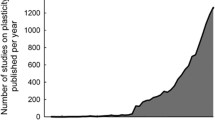Summary
A genotype is said to show phenotypic plasticity if it can produce a range of environmentally dependent phenotypes. Plasticity may or may not be adaptive. We consider plasticity as a genetically determined trait and thus find the optimal response of an animal to its environment. Various aspects of this optimal response are illustrated with examples based on reproductive effort. We investigate the selection pressure for plastic as opposed to fixed strategies. An example with spatial heterogeneity is used to compare our approach with that of Stearns and Koella (1986).
Similar content being viewed by others
References
Bradshaw, A. D. (1965). Evolutionary significance of phenotypic plasticity in plants.Adv. Genet. 13, 115–55.
Caswell, H. (1989)Matrix Population Models. Sinauer, Sunderland, MA, USA.
Charlesworth, B. (1980)Evolution in Age-Structured Populations. Cambridge University Press, Cambridge, UK.
Fisher, R. A. (1958)The Genetical Theory of Natural Selection. Dover, NY, USA.
Houston, A. I. and McNamara, J. M. (1992) Phenotypic plasticity as a state-dependent life-history decision.Evol. Ecol. 6, 243–53.
McNamara, J. M. (1992) Optimal life histories: a generalisation of the Perron-Frobenius Theorem.Theor. Pop. Biol. 40, 230–45.
McNamara, J. M. and Houston, A. I. (1986) The common currency for behavioural decisions.Am. Nat. 127, 358–78.
Mangel, M. and Clark, C. W. (1986) Towards a unified foraging theory.Ecology 67, 1127–38.
Mangel, M. and Clark, C. W. (1988)Dynamic Modelling in Behavioural Ecology. Princeton University Press, Princeton.
Price, T. and Liou, L. (1989) Selection on clutch size in birds.Am. Nat. 134, 950–9.
Stearns, S. C. (1982) The role of development in the evolution of life-histories. InThe Role of Development in Evolutions (J. T. Bonner, ed.), Springer-Verlag, NY, USA.
Stearns, S. C. and Koella, J. C. (1986) The evolution of phenotypic plasticity in life-history traits: predictions of reaction norms for age and size at maturity.Evolution 40, 893–913.
Tuljapurkar, S. (1989) An uncertain life: demography in random environments.Theor. Pop. Biol. 35, 227–94.
Via, S. and Lande, R. (1985) Genotype-environment interaction and the evolution of phenotypic plasticity.Evolution 39, 505–22.
Author information
Authors and Affiliations
Rights and permissions
About this article
Cite this article
Houston, A.I., McNamara, J.M. Phenotypic plasticity as a state-dependent life-history decision. Evol Ecol 6, 243–253 (1992). https://doi.org/10.1007/BF02214164
Issue Date:
DOI: https://doi.org/10.1007/BF02214164




